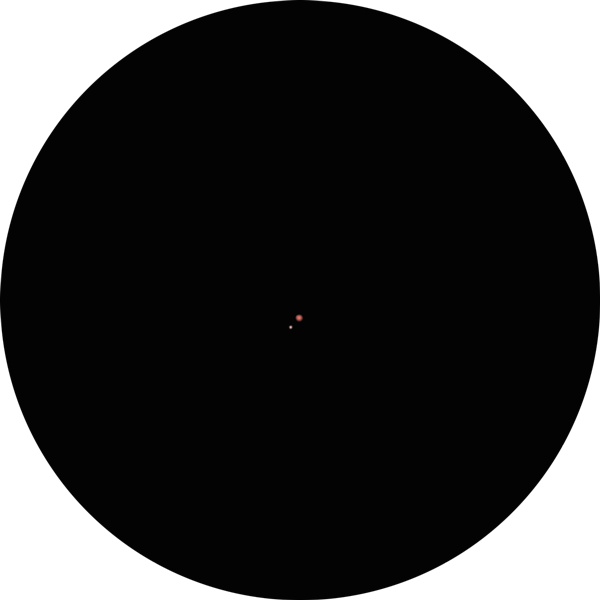Nestled in the northern constellation of Canes Venatici, Latin for “the Hunting Dogs,” the double star 2 Canum Venaticorum (also known as Struve 1622) offers a captivating sight for those who love double stars. Observers can catch this pair in the northern sky in the spring and early summer months near the more famous constellation Ursa Major.
The primary star’s luminosity and color make it a striking target for observation. It stands out against the backdrop of the night sky as a red giant with the spectral type M3III. This star may look like a tiny dot in the eyepiece with a magnitude of +5.8, but its diameter is 100 times larger than our sun’s! The secondary star is dimmer at a magnitude of +8.7, lying 11.6 arcseconds away. It is a yellow-white star with a stellar classification of F7V.1 The distance between the two stars is close, but backyard astronomers with any modest scope should be able to distinguish them.
The astronomer William Herschel first observed 2 Canum Venaticorum on November 13, 1782. Since Canes Venatici is higher in the sky in spring, and Herschel recorded the pair in winter, I assume Herschel was observing with his scope in the early morning hours before sunrise.2
My Observations
This is my first observation of the night after a few months’ hiatus. What a great star system to start my night with! The primary star is a vibrant red/orange, while the fainter secondary star appears white with a slight yellow tinge.
As I gaze at this pair shining through the eyepiece, my thoughts drift to William Anders, the former Apollo 8 astronaut who captured the iconic “Earthrise” photograph during his orbit around the moon in December 1968. Mr. Anders passed away earlier today in a plane crash at the age of 90, about 75 miles north of where I observe tonight. Thanks to individuals like Mr. Anders, future generations will be inspired to “look up” and appreciate the beauty of the universe. I believe he would have loved a clear, beautiful night like tonight.
| Date | June 7, 2024 |
| Time | 10:36 p.m. |
| Location | Seattle, WA |
| Magnification | 169x |
| Scope | Meade 8″ SCT |
| Eyepiece | 12mm |
| Seeing | Above Average |
| Transparency | Above Average |

Key Stats
| Constellation | Canes Venatici |
| Best Viewing | Spring |
| Visual Magnitude | +5.8 | +8.7 |
| Distance from Earth | 1399 ly |
| Separation | 11.6″ |
| Milky Way Location | Orion Spur |
| My Viewing Grade | A- |
| Designations | SAO 44097, 2 CVn, STF 1622, HIP 59827, HD 106690, HR 4666 |
Sources and Notes
The double star banner on this page is an artist’s impression showing the double star OGLE-LMC-CEP0227 in our neighboring galaxy the Large Magellanic Cloud. This media was created by the European Southern Observatory (ESO). This file is licensed under the Creative Commons Attribution 4.0 International license.
1 Stelledoppie.it. (n.d.). 2 Canum Venaticorum. Retrieved June 9, 2024, from https://www.stelledoppie.it/index2.php?iddoppia=53333
2 Handprint.com. (n.d.). The Herschel objects. Retrieved June 9, 2024, from https://www.handprint.com/ASTRO/Herschel_All.html
Sketch by Wayne McGraw
